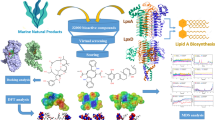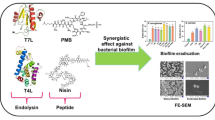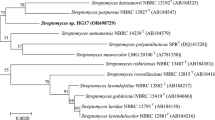Abstract
The in vitro cytotoxicity of the antimicrobial peptide P40 was investigated. The food grade bacteriocin nisin was also analyzed for comparison. VERO cells were treated with different concentrations (0.02–2.5 μg ml−1) of nisin and P40, and cell viability and plasma membrane integrity were checked by MTT, neutral red uptake (NRU), and lactate dehydrogenase (LDH) assays. In MTT and NRU assays the EC50 to the purified peptide P40 were 0.30 and 0.51 μg ml−1, while values found to nisin were 0.35 and 0.79 μg ml−1, respectively. In the LDH assay, the EC50 was 0.57 and 0.62 μg ml−1 for P40 and nisin, respectively. The peptide P40 revealed higher hemolytical activity (19%) when compared to nisin (4.9%) at the highest concentration tested (2.5 μg ml−1). Relatively few studies about the cytotoxicity of antimicrobial peptides are available. The determination of the cytotoxicity of antimicrobial peptides is an essential step to warrant their safe use.

Similar content being viewed by others
References
Aranha C, Gupta S, Reddy KV (2004) Contraceptive efficacy of antimicrobial peptide nisin: in vitro and in vivo studies. Contraception 69:333–338
Bizani D, Dominguez APM, Brandelli A (2005) Purification and partial chemical characterization of the antimicrobial peptide cerein 8A. Lett Appl Microbiol 41:269–273
Borenfreund E, Puerner JA (1984) A simple quantitative procedure using monolayer culture for toxicity assays. J Tissue Cult Methods 9:7–9
Bouaziz C, Abid-Essefi S, Bouslimi A, El Golli E, Bacha H (2006) Cytotoxicity and related effects of T-2 toxin on cultured Vero cells. Toxicon 48:343–352
Cladera-Olivera F, Caron GR, Brandelli A (2004) Bacteriocin-like substance production by Bacillus licheniformis strain P40. Lett Appl Microbiol 38:251–256
Cladera-Olivera F, Caron GR, Motta AS, Souto AA, Brandelli A (2006) Bacteriocin-like substance inhibits potato soft rot caused by Erwinia carotovora. Can J Microbiol 52:533–539
Decker T, Lohmann-Matthes ML (1988) A quick and simple method for the quantitation of lactate dehydrogenase release in measurements of cellular cytotoxicity and tumor necrosis factor (TNF) activity. J Immunol Methods 115:61–69
Deegan LH, Cotter PD, Hill C, Ross P (2006) Bacteriocins: biological tools for bio-preservation and shelf-life extension. Int Dairy J 16:1058–1071
Kaplan A, Szabo LL, Opheim KE (1988) Clinical chemistry: interpretations and techniques. Lea & Febigem, Philadelphia
Kordel M, Sahl HG (1986) Susceptibility of bacterial, eukaryotic, and artificial membranes to the disruptive action of the cationic peptides pep5 and nisin. FEMS Microbiol Lett 34:139–144
Macián M, Seguer J, Infante MR, Selve C, Vinardell MP (1996) Preliminary studies of the toxic effects of non-ionic surfactants derived from lysine. Toxicology 106:1–9
Maher S, McClean S (2006) Investigation of the cytotoxicity of eukaryotic and prokaryotic antimicrobial peptides in intestinal epithelial cells in vitro. Biochem Pharmacol 71:1289–1298
Mason AJ, Marquette A, Bechinger B (2007) Zwitterionic phospholipids and sterols modulate antimicrobial peptide-induced membrane destabilization. Biophys J 93:4289–4299
Mikkola R, Kolari M, Andersson MA, Helin J, Salkinoja-Salonen MS (2000) Toxic lactonic lipopeptide from food poisoning isolates of Bacillus licheniformis. Eur J Biochem 267:4068–4074
Mossmann T (1983) Rapid colorimetric assay for cellular growth and survival: application to proliferation and cytotoxicity assays. J Immunol Methods 65:55–63
Murinda SE, Rashid KA, Roberts RF (2003) In vitro assessment of the cytotoxicity of nisin, pediocin, and selected colicins on simian virus 40-transfected human colon and Vero monkey kidney cells with trypan blue staining viability assays. J Food Prot 66:847–853
Papo N, Shai Y (2005) Host defense peptides as new weapons in cancer treatment. Cell Mol Life Sci 62:784–790
Reddy KVR, Yedery RD, Aranha C (2004) Antimicrobial peptides: premises and promises. Int J Antimicrob Agents 24:536–547
Shin SY, Lee SH, Yang ST, Park EJ, Lee DG, Lee MK, Eom SH, Song WK, Kim Y, Hahm KS, Kim JL (2001) Antibacterial, antitumor and hemolytic activities of α-helical antibiotic peptide, P18 and its analogs. J Pept Res 58:504–514
Teixeira ML, Cladera-Olivera F, Santos J, Brandelli A (2009) Purification and characterization of a peptide from Bacillus licheniformis showing dual antimicrobial and emulsifying activities. Food Res Int 42:63–68
Von Döhren H (1995) Peptides. Biotechnology 28:129–171
Weyermann J, Lochmann D, Zimmer A (2005) A practical note on the use of cytotoxicity assays. Int J Pharm 288:369–376
Acknowledgments
Authors thank P.M. Roehe, A.C. Franco of ICBS/UFRGS and D. Cantarelli of IPB/PUCRS for technical support with Vero cells. This work was supported by grants from CNPq and CAPES, Brazil.
Author information
Authors and Affiliations
Corresponding author
Rights and permissions
About this article
Cite this article
Vaucher, R.A., Teixeira, M.L. & Brandelli, A. Investigation of the Cytotoxicity of Antimicrobial Peptide P40 on Eukaryotic Cells. Curr Microbiol 60, 1–5 (2010). https://doi.org/10.1007/s00284-009-9490-z
Received:
Revised:
Accepted:
Published:
Issue Date:
DOI: https://doi.org/10.1007/s00284-009-9490-z




